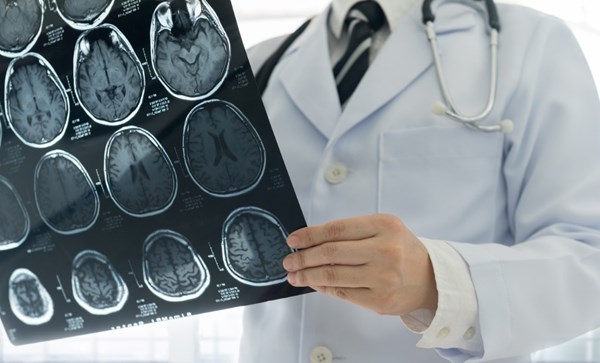Just over half of brain injury patients got recommended scans; uninsured fared worse.
Traumatic brain injury (TBI) is a severe, life-threatening presentation resulting from many different clinical conditions. Because treatment and management vary significantly by the underlying cause, computed tomography (CT) imaging studies are necessary to distinguish among the potential pathologies. In a retrospective cohort study of nearly 60,000 cases across 682 hospitals from 2010 to 2015, researchers from New York report a statistically significant disparity in receipt and number of CTs received between insured and uninsured adult patients with severe TBI within the first 24 hours following hospital admission. Receipt of a head CT and the number of head CTs received were considered primary outcomes in this study, with receipts of angiography, magnetic resonance imaging (MRI), or plain film x-ray considered secondary outcomes.
These authors report 4.46 per 100 fewer uninsured patients received a CT imaging study and 11% fewer total imaging studies in the first 24 hours after admission compared to insured patients with the same ICD-9 diagnosis. The authors offer several potential explanations: uninsured patients might refuse elective CTs due to anticipated personal cost; institutions might pressure clinicians to reduce operating costs; unconscious provider bias; or providers might be altruistic and attempt to minimize the patients’ out-of-pocket costs.
The authors also report no statistical significance in primary outcomes after 24 hours of admission nor were differences observed in secondary outcomes at any time. Also, just over half (53.3%) of all reviewed cases received a CT, despite established imaging guidelines which recommend that all of these patients receive a CT scan. This suggests poor provider compliance with insured patient populations as well. While the immediate reaction to this report may be to assume insured patients are receiving a higher standard of care than uninsured patients, the authors state that this result is more likely due to other confounding variables. Namely, uninsured populations maintain a poorer baseline health status, greater incidence of polytrauma, and higher likelihood to receive treatment from lower-performing healthcare facilities, among others. This study serves as a reminder to clinicians to include diagnostic CT imaging in all TBI patients when clinically indicated regardless of patient insurance status, and a a call for policymakers to investigate this disparity further in order to reduce the association between uninsurance and mortality.
PMID: 29039720
Renson A, Schubert FD, Bjurlin MA. Lack of Health Insurance Associated With Lower Probability of Head Computed Tomography Among United States Traumatic Brain Injury Patients. Current neurology and neuroscience reports. Published December 2018.
Abstract
BACKGROUND: Uninsured traumatic brain injury (TBI) patients have higher mortality than their insured counterparts. One possible reason is disparities in receipt of appropriate diagnostic imaging. OBJECTIVE: Examine the association between lack of insurance and use of diagnostic imaging.
RESEARCH DESIGN: This is a retrospective cohort study.
SUBJECTS: All adult patients admitted with severe (AIS>4 and GCS<15) TBI, in the National Trauma Data Bank 2010-2015.
MEASURES: Primary outcome was receipt of head computed tomography (CT) and number of CT scans received. Secondary outcomes included head x-ray, angiography, or magnetic resonance imaging. Patients were classified as uninsured if their payment method was self-pay or not billed.
RESULTS: Of 59,540 patients meeting inclusion criteria, 18.9% were uninsured. After adjusting for demographic, clinical, and facility characteristics, compared with patients with any insurance, 4.47 per 100 (95% confidence interval, 1.60-7.34) fewer uninsured patients had a head CT, with uninsured patients receiving 13% (95% confidence interval, 3-21) fewer head CTs. There were no differences in x-ray, angiography, or magnetic resonance imaging receipt.
CONCLUSIONS: Findings suggest lower receipt of guideline-indicated head CT among uninsured TBI patients. Mechanisms could include unconscious provider bias or institutional financial constraints. Further research is warranted to elucidate mechanisms and assess mediation by diagnostic imaging use of the insurance-mortality association.
EMRA + PolicyRx Health Policy Journal Club: A collaboration between Policy Prescriptions and EMRA
 As emergency physicians, we care for all members of society, and as such have a unique vantage point on the state of health care. What we find frustrating in our EDs - such as inadequate social services, the dearth of primary care providers, and the lack of mental health services - are universal problems.
As emergency physicians, we care for all members of society, and as such have a unique vantage point on the state of health care. What we find frustrating in our EDs - such as inadequate social services, the dearth of primary care providers, and the lack of mental health services - are universal problems.
As EM residents and fellows, we learn the management of myocardial infarctions and traumas, and how to intubate, but we are not taught how health policy affects all aspects of our experience in the ED. Furthermore, given our unique position in the health care system, we have an incredible opportunity to advocate for our patients, for society, and for physicians. Yet, with so many competing interests vying for our conference education time, advocacy is often not included in the curricula.
This is the gap this initiative aims to fill. Each month, you will see a review of a new health policy article and how it is applicable to emergency physicians.



